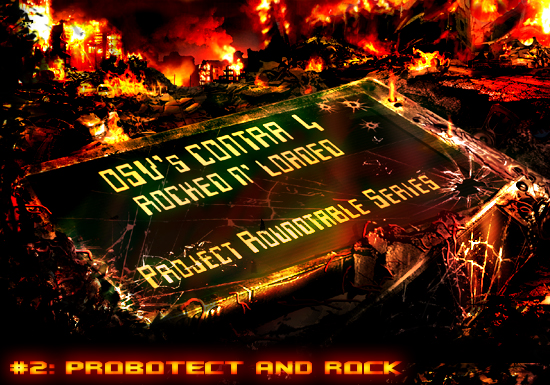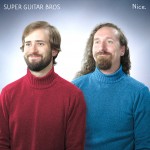A few weeks ago we had the first part of our discussion with the Contra 4: Rocked ‘n’ Loaded team about the development and production of these kinds of arrangement albums. It’s easy to take arrangements and remixes for granted, thinking it’s simply a deal of finding a MIDI or listening by ear and replicating it, but in reality, the process is quite a massive undertaking.
In this part, we ventured into the topic of the music production itself, as we last time went into the topic of planning, signing artists and working together. Now get ready to really understand how long it takes to transcribe, learn and record these incredibly detailed melodies, and dealing with being a musical perfectionist.
Come Get Some!
OSV: Alright so let’s move onto the actual production and stuff. First though, let me ask you, In terms of sound and direction, did any other arrangement album influence you, either official or fan produced?
Snappleman: Well, the arrange album that influences everything I do since I first heard it has been F-Zero X Guitar Arrange Edition. Also, I really like the style of IOSYS, S.S.H. and the Black Mages.
Prince of Darkness (PoD): Not directly in the case of this project. Of course, Project Chaos is a huge influence on my remixing in general, but it doesn’t have direct influence on what I do. Then again, I collaborate with a couple Project Chaos contributors, so maybe? Moreso, what I do and have done influences me more than anything. It’s always a constant learning process and every time I make a song I’ll find what works and what doesn’t work and add that to my “library” of composing tricks.
OSV: What are the usual tools of the trade for arranging and recording music? And what did you use on Rocked ‘n’ Loaded (RnL)?
Snappleman: Well, there are basically three things we all use to create music, Starting with a computer! Without a good computer to work on you really can’t do much these days in terms of full production. Then you need a DAW (digital audio workstation), which is software that behaves like a recording studio, and allows you to record audio and MIDI tracks and manipulate the sound. The third is some type of instrument to record and perform on. On RnL I used Steinberg Cubase as my DAW, and I recorded my guitars, bass and keyboards.
PoD: What he said. My first few remixes (including the first draft of “Metropolis Massacre” [track 7 on RnL]) were done on my crappy Dell desktop from 2003, with a 2.0 GHz processor and 1 GB of RAM. I had to arrange outside Cubase and then do everything in steps once I put it together in Cubase. Essentially, I could really only process one instrument at a time from my sample libraries because that’s all the computer could handle.
OSV: So once you have everything ready, how do you go about starting an arrangement?
Snappleman: First thing I do is import the song as an audio file. This lets me listen to it as I play and record scratch tracks which help me learn the song and arrange it in my head. I then start recording the parts of the song that I can hear on keyboards, starting with the melody, then bass, and so on. Eventually I have a re-creation of the song, except the tracks are all seperate, so I can listen to any specific of the song I want, and get ideas on expanding it. In the case of Contra 4, it helped knowing Jake Kaufman because I could go to him and ask him about parts that were very hard to hear. As it turns out, the Contra 4 music is incredibly complex and layered!
PoD: I have somewhat of a strange approach. When it comes to metal, a lot of times I will arrange into Guitar Pro. I’m a pretty fast sightreader and the majority of music you’ve heard me play is me reading off riffs in Guitar Pro while recording. Both “Metropolis Massacre” and “BRICKWALLER” (track 4 off RnL) were arranged into Guitar Pro. Using Guitar Pro also helps me really dial in and organize the right riffs, instead of screwing around trying to improvise riffs into a song. It works for Snappleman, but I can’t do it that well. Once all parts are written down I’ll do them in Cubase. Normally I’ll start with a temporary drum track, because I like doing drums later, so I make sure they fit with the song well, since a bit ends up changed when I record songs. With the drum track, I’ll record rhythm guitars, then bass, then keyboards and sequencing, then lead guitars and lead keyboards. Drums will probably come last or at least after the keyboards and sequencing.
OSV: Does this mean you had a hard time arranging the music?
Snappleman: Very much so! The songs are full of things which you can’t hear until they’re taken out, then you notice a hole. Most of our time was spent learning the music, and getting our hands and minds to memorize the complicated patterns for playing the parts.
PoD: I didn’t have too tough of a time arranging my songs, as there’s a lot to them and there are so many layers, so there’s a lot of stuff to use. Playing them is a different story! Commonly I’ll approach an arrangement where I’ll have an intro, I play through the full song once, do some solos and other stuff, and then I’m done. It’s pretty simple and stupid, but also effective.
OSV: Can you give us an example of a particular song?
Snappleman: Take the song “Jungle Exploder” (track 2 on the album). This song is very good proof that Jake is influenced by Konami music on the NES. He uses a lot of counterpoint and arpeggiating to fill out a song the same way they did it on the NES. Since the NES had very limited sound channels, complex chords were not possible, so programmers developed tricks to fill out the sound. These tricks may sound great, but they’re extremely hard to play on an instrument like a guitar! So there was a lot of practice put into learning those parts to record this song.
PoD: The very first Guitar Pro draft of “Metropolis Massacre” was initially about 3 minutes in length. It was very short, didn’t have any of the solos and was missing some other sections, and for whatever reason I thought that was fine. Snappleman said I should add more, so I expanded a lot and added the guitar and keyboard solos, which added quite a bit of length. It was all for the better.
OSV: So how long then, does it take to record all the tracks in a song?
Snappleman: I had “Jungle” recorded within a week of starting it. But as with any song I work on, those takes were not final. I have re-recorded “Jungle” many many times since then!
PoD: I can generally blast through rhythm guitars in 4-5 hours, bass in an hour or two, but lead guitars and keyboards will take a bit longer since I am a pretty inconsistent player on both.
OSV: How complicated do these songs get from the recording aspect?
Snappleman: Well, most of these songs have a great big number of tracks. Tracks are like layers, each track contains one part of the song. It could be the snare drum, lead guitar, bass guitar, strings, anything really. On average, my songs on this album contain about 35-60 tracks. Some artists use many many more! But it’s not always a complete instrument that’s on a track. Some tracks can contain just little pieces of something, or sound effects. It’s all a matter of how much control the artist wants over the song. The real trouble is putting all these tracks together!
PoD: They can get insane. I have many tracks in my projects and hundreds of takes on really difficult music like “Bass Fishing’s” (track 6 on RnL) basslines. It’s either dedication or stupidity that keeps us going. Or both.
OSV: All of these songs are very heavy and they sound very “full” and sometimes a little loud. How do you go about putting together a song from it’s parts or tracks?
Snappleman: That’s the really hard part. With songs that have these many layers, mixing them is very hard work. A distorted guitar can literally eat up the entire sound spectrum if you let it! Depending on your amp settings and EQ. The trick is to “slot” or shape the sounds to make them all fit together. A drumkit generally features a sound that fits into every part of the spectrum. The kick drum fills out the lows, snare and toms fill out the mids, and the hihats and cymbals fill out the highs. The first thing I do is get a good balance to the drumkit by itself, and then I start to bring in the bass guitar. Once I can hear the both the kick drum and bass guitar without one overpowering the other, I have a good foundation for the rest of the song! Then I start to bring in the distorted rhythm guitars, which are constantly playing loud chords and heavy fast passages which can really eat up the low-mid range. What I try to do here, is figure out where exactly the guitars frequency is not important (this is usually where the bass is most present) and I cut out a bit of EQ there, I do this all over so the guitar fits in as well as it can without covering up other sounds. I repeat this for every other track and then a mix one step closer to being done!
OSV: So EQ editing helps tracks fit together to form a song. What happens when you have two or more instruments which have a similar desired frequency?
Snappleman: There are many methods to deal with this. The main one I use is called compression. With compression you can take a sound and make the quieter parts of the sound louder without changing the overall volume of the sound. This way, you can bring out more of an instruments character and make it sound bigger in the mix. If you bring out just enough character from every sound in your song, and EQ them right, you then have a very solid base of a mix. You can then add effects such as delay and reverb to give it that extra bit of sparkle.
OSV: So Snappleman, you and the other members of the RnL team are all very handsome men. Does that have anything to do with the quality of your music?
PoD: Handsome men for manly music of the manliest game on the manliest remix album ever. What could be better?
Snappleman: For me, it does. I enjoy being a handsome man. But I have a question for you. Does me being so handsome affect your enjoyment of my music?
OSV: Oh very much so. Let me go back to when we first met. It was very special to me, because I had never met someone so tall, tanned and masculine, and I have to admit I was a bit intimidated at first. But you are very gentle and somewhat tender at heart. This was obviously enhanced when we took that trip to Spain together and I got food poisoned on sea food, you took care of me all night. So when I listen to your music, I hear a very rugged man, that knows what a man should sound like, and what a man should do.
Snappleman: I am very happy that you remember that night, Audun. I take pleasure in capturing that feeling of tender, yet firm manliness in every song I record.
(To be continued…)
__
You can now pre-order the CD at the Contra 4: Rocked n’ Loaded website and listen to samples as always on their YouTube channel. Check back next time entry where we’ll be going into detail about the art direction and hear from Jake Kaufman himself!
[Banner by Nate Horsfall]
Tags: Arrangements, Contra, Contra 4, Features, Jake Kaufman, Projects, Remixes, Roundtables, Snappleman, Tony Dickinson, virt









































Needs more homoerotic fanfic. Other than that, good job!